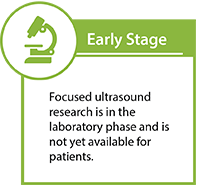Focused Ultrasound Therapy
Focused ultrasound is a noninvasive, therapeutic technology with the potential to improve the quality of life and decrease the cost of care for patients with disc degeneration. This novel technology focuses beams of ultrasound energy precisely and accurately on targets deep in the body without damaging surrounding normal tissue.
How it Works
Where the beams converge, focused ultrasound produces several therapeutic effects that are being evaluated to treat disc disease. One mechanism is precise ablation (thermal destruction of tissue) of the nerves that cause pain secondary to disc disease. A second mechanism involves focused ultrasound drugs release from nanoparticles that will degrade the ruptured intravertebral disc. A third mechanism is to use focused ultrasound to degrade the dysfunctional disc so it can be aspirated with a fine needle. After it has been removed, an injection of biomaterial can be accomplished. An additional mechanism is evaluating the use of a focused ultrasound activated hydrogel to restore the disc space.
While there has been preclinical investigation of focused ultrasound to treat degenerative discs, additional research is needed before this will be available for clinical use.
Recent work has been on treating the arthritis of the facet joint. See “Back Pain” for added discussion on this topic.
Advantages
The primary options for treatment of disc degeneration include medication and invasive surgery.
For certain patients, focused ultrasound could provide a noninvasive alternative to surgery with less risk of complications – such as surgical wound healing or infection – at a lower cost. Focused ultrasound can reach the desired target without damaging surrounding tissue, and it can be repeated, if necessary.
Clinical Trials
At the present time, there are no clinical trials recruiting patients for focused ultrasound treatments of disc degeneration.
Regulatory Approval and Reimbursement
Focused ultrasound treatment for disc degeneration is not yet approved by regulatory bodies or covered by medical insurance companies.
Notable Papers
Adams M, Lotz JC, Diederich C. In silico feasibility assessment of extracorporeal delivery of low-intensity pulsed ultrasound to intervertebral discs within the lumbar spine. Phys Med Biol. 2020 Jul 3. doi: 10.1088/1361-6560/aba28d.
Qiao S, Elbes D, Boubriak O, Urban JPG, Coussios CC, Cleveland RO. Delivering Focused Ultrasound to Intervertebral Discs Using Time-Reversal. Ultrasound Med Biol. 2019 May 30. pii: S0301-5629(19)30180-2. doi: 10.1016/j.ultrasmedbio.2019.04.023.
Nguyen K, Pan HY, Haworth K, Mahoney E, Mercado-Shekhar KP, Lin CY, Zhang Z, C Park Y. Multiple-Exposure Drug Release from Stable Nanodroplets by High-Intensity Focused Ultrasound for a Potential Degenerative Disc Disease Treatment. Ultrasound Med Biol. 2019 Jan;45(1):160-169. doi: 10.1016/j.ultrasmedbio.2018.09.014. Epub 2018 Oct 26.
Karakitsios I, Mihcin S, Saliev T, Melzer A. Feasibility study of pre-clinical Thiel embalmed human cadaver for MR-guided focused ultrasound of the spine. Minim Invasive Ther Allied Technol. 2016;25(3):154-61. doi: 10.3109/13645706.2016.1150297. Epub 2016 Feb 29.
Forslund C, Persson J, Strömqvist B, Lidgren L, McCarthy ID. Effects of high-intensity focused ultrasound on the intervertebral disc: a potential therapy for disc herniations. J Clin Ultrasound. 2006 Sep;34(7):330-8.

